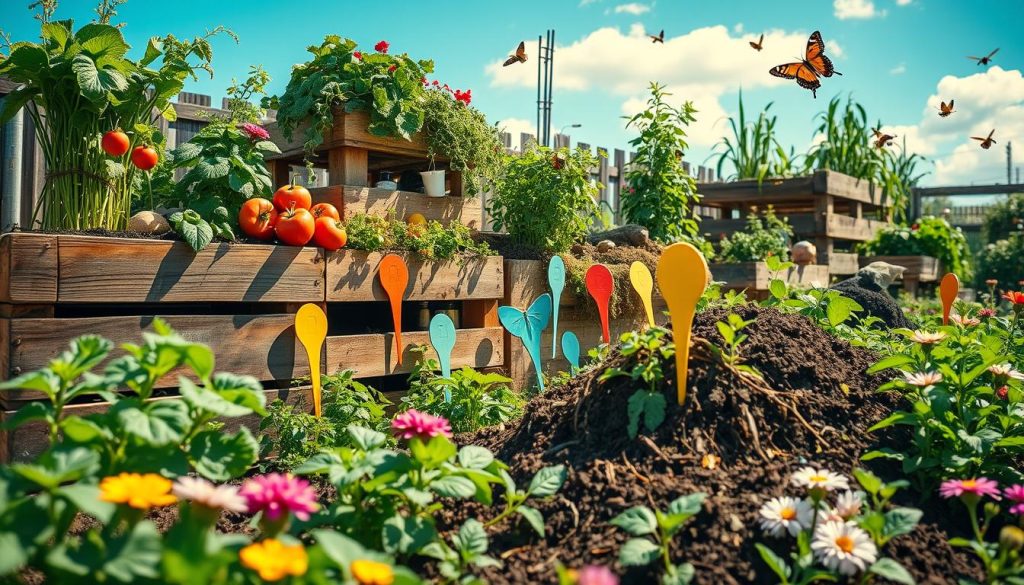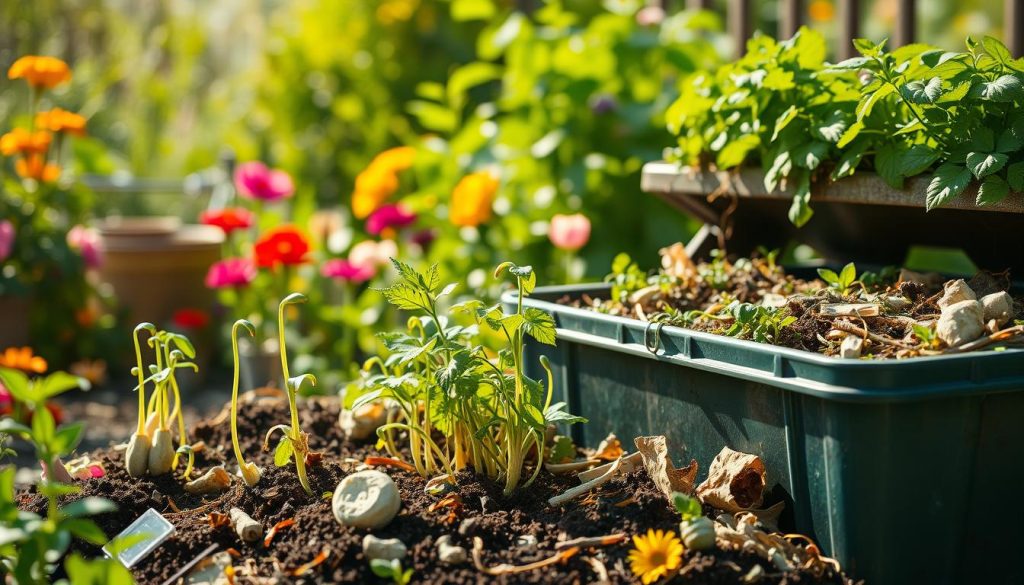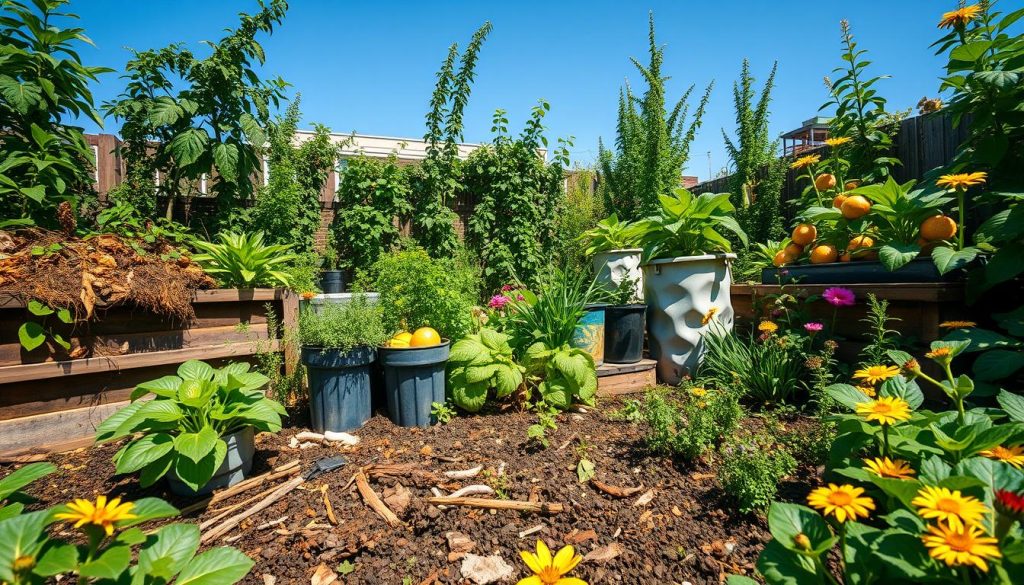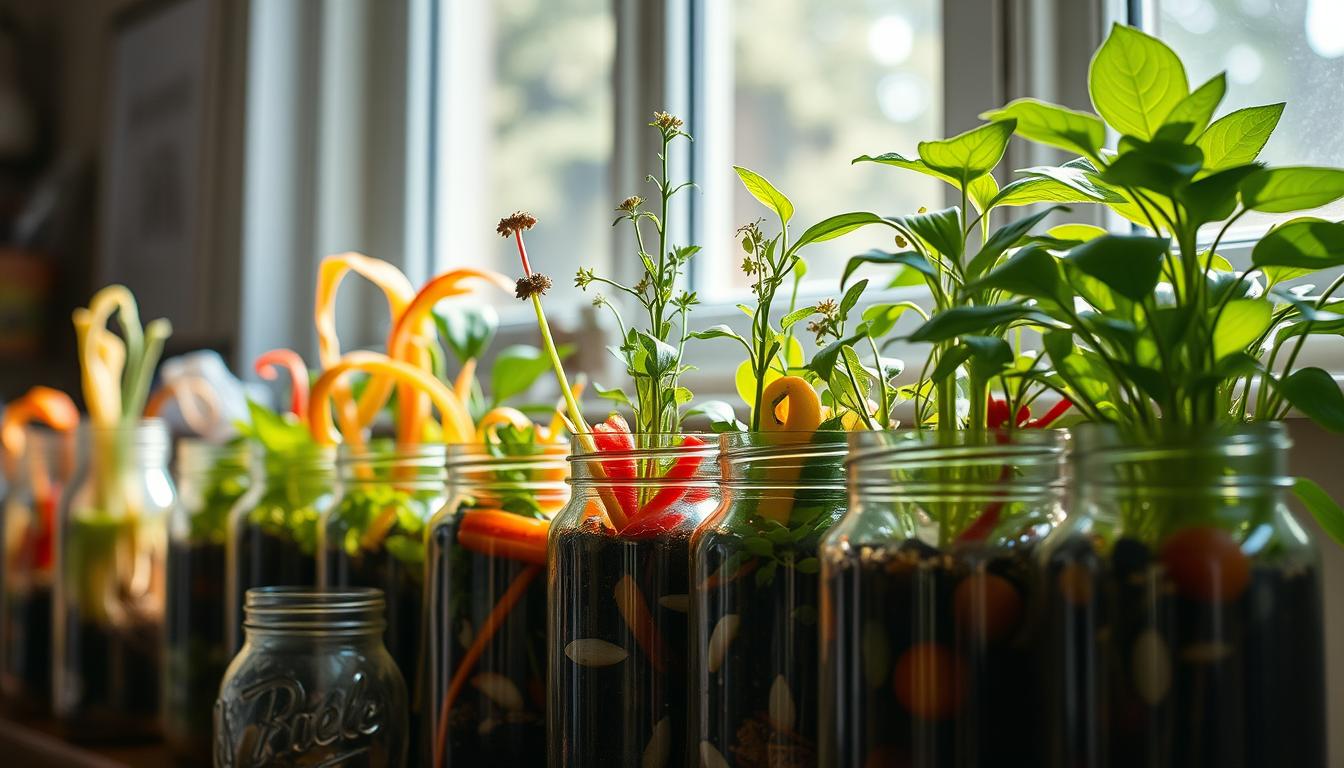I’m excited to share my zero-waste gardening journey. It has greatly reduced my environmental impact. I’ve also enjoyed the benefits of sustainable gardening.
By using kitchen scraps, I’ve turned them into a thriving garden. I’m here to guide you through this process.
Starting my zero-waste gardening journey showed me how to reduce waste. It’s a simple way to help the environment. Anyone can do it, no matter their gardening skills.
My journey has shown me the joys of sustainable gardening. It’s not just good for the planet. It’s also rewarding to grow your own food.
In this article, I’ll share my experiences. I’ll also guide you on how to start your own zero-waste garden. We’ll explore the benefits and the easy steps to follow.
What is Zero-Waste Gardening?
Exploring gardening, I’ve learned the value of a zero-waste lifestyle. It reduces my environmental impact and makes the most of what I have. Using kitchen waste to make compost helps my plants grow well.
Zero-waste gardening aims to cut down on waste and use what we have wisely. It’s good for the planet, saves water, and supports different species. By composting kitchen waste, my garden is now sustainable and eco-friendly.
Defining Zero-Waste Concepts
To grasp zero-waste gardening, we must understand what it means. In gardening, it’s about reducing, reusing, and recycling to cut waste. This includes using recycled materials, composting, and avoiding plastics.
Benefits of Zero-Waste Gardening
Zero-waste gardening offers many advantages:
- Less greenhouse gas emissions
- Water conservation
- Supports biodiversity
- Healthier soil
- Better crop yields
By living zero-waste and using organic gardening tips, I’ve built a sustainable garden. It’s good for the planet and gives me fresh, healthy food.

Getting Started with Kitchen Scraps
To start upcycling in gardening, knowing what kitchen scraps to use is key. By composting, you can make soil that helps plants grow. You can use peels from fruits and veggies, tea bags, and eggshells as natural fertilizer.
Getting the right tools is important. You’ll need a compost bin, shovel, and watering can. Here are more tools to think about:
- A gardening glove to protect hands from thorns and dirt
- A pruning tool to trim and shape plants
- A trellis or support system for climbing plants
Using these tools and methods can help you reduce waste and grow a healthy garden. It’s all about upcycling and DIY composting.

How to Prepare Scraps for Planting
To make a garden grow well, you need to prepare your scraps right. This means cleaning and picking the best scraps. Also, setting up your garden space is key for growth. By doing this, you can make your garden eco-friendly and waste-free.
When getting ready to plant, clean the scraps well. Rinse them with water and check for damage. Then, pick the best scraps for planting, thinking about size and type.
Cleaning and Selecting Scraps
- Remove any leaves or stems that are damaged or diseased
- Rinse the scraps with water to remove any dirt or debris
- Inspect the scraps for any signs of pests or decay
After cleaning and choosing your scraps, set up your garden. Pick a spot with lots of sunlight and good drainage. Prepare the soil with nutrients for your plants. This way, you’ll have a garden that’s good for the planet and gives you fresh food.

Setting Up Your Garden Space
By following these steps, you can have a garden that’s full of life. It will give you healthy food and help the planet. Always choose eco-friendly gardening to keep your garden healthy and green.
The Best Vegetables to Grow from Scraps
As I explore zero-waste gardening, I’ve found joy in growing veggies from kitchen scraps. This method cuts down on waste and helps create a sustainable food system. It lets people move away from industrial farming and towards organic gardening for a healthier planet.
Zero-waste gardening from kitchen scraps offers a wide range of veggies to grow. You can grow greens like lettuce and celery, root veggies like potatoes and carrots, and herbs like basil and green onions. These are great for beginners because they’re easy to grow and need little care.
Greens: Lettuce and Celery
Greens like lettuce and celery are super easy to grow from scraps. They need little care and can be ready in just two weeks. To grow them, just put the base of the lettuce or celery in water and wait for it to sprout.
Root Vegetables: Potatoes and Carrots
Root veggies like potatoes and carrots can also be grown from scraps. To grow potatoes, cut a potato into sections with at least one eye each. Then, plant them in soil and wait for them to sprout. Carrots can be grown by planting the top in soil.
Herbs: Basil and Green Onions
Herbs like basil and green onions are also easy to grow from scraps. To grow basil, just put the stem in water and wait for it to sprout. Green onions can be grown by planting the base in soil. By following these tips, you can reduce waste and help the planet.
Harvesting and Maintaining Your Garden
My journey to zero-waste gardening has taught me a lot. I’ve learned how to harvest and maintain my garden right. Upcycling and DIY composting have helped me cut down on waste and grow a healthy garden. Using drip irrigation or soaker hoses saves water and reduces waste.
To keep my garden in top shape, I use natural pest control. Companion planting and crop rotation are my go-to methods. They keep pests away and help my plants grow strong. Plus, they make my soil rich in nutrients, which is great for my plants.
Watering Techniques for Scrap-Grown Plants
- Use drip irrigation or soaker hoses to conserve water and reduce waste
- Water plants deeply but infrequently to encourage deep root growth
- Monitor soil moisture to avoid overwatering
Pest Control, Naturally
Natural pest control methods have been a game-changer for me. Companion planting and crop rotation keep pests at bay and help my plants thrive. These methods also mean I don’t need harmful chemicals. Upcycling and DIY composting have helped me create a balanced garden ecosystem. This supports my plants and reduces waste.
Creative Ways to Utilize Kitchen Scraps
My journey to zero-waste gardening has shown me the value of using kitchen scraps. I’ve learned to compost and use green gardening techniques. This has cut down on waste and made my garden more efficient.
Composting Beyond the Garden
Composting is key to reducing waste and making a valuable resource for my garden. It turns kitchen scraps into a natural fertilizer. This has greatly improved my garden’s soil and plant health.
Kitchen Scrap Recipes for the Home Chef
I’ve also found ways to use kitchen scraps in cooking. From soups to salads, the options are endless. Here are some of my top recipes:
- Vegetable broth from leftover vegetable scraps
- Compost tea, a liquid fertilizer from composted scraps
- Stir-fries with leftover veggies and herbs
By using these green gardening methods, I’ve created a system that reduces waste. It makes my garden more efficient.
Reflecting on My Zero-Waste Gardening Experience
Looking back, I feel proud and thankful for my zero-waste gardening journey. Growing my own food has taught me so much. Patience and persistence are crucial for a thrivingzero waste lifestylegarden.
I’ve enjoyed trying neworganic gardening tipsand seeing my hard work pay off. It’s rewarding to see my garden grow.
Being creative has been a big lesson. Turning kitchenwaste compostingscraps into plants has shown me the power of zero-waste gardening. I’m eager to grow more and find new ways to reduce waste.
My next step is to share what I’ve learned. I want to inspire others to live azero waste lifestyle. Together, we can make the world more sustainable, one garden at a time.

